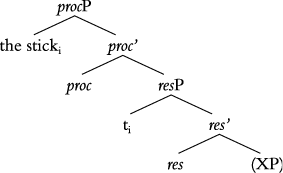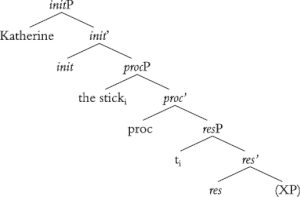
In linguistics, conjugation is the creation of derived forms of a verb from its principal parts by inflection. For instance, the verb break can be conjugated to form the words break, breaks, broke, broken and breaking. While English has a relatively simple conjugation, other languages such as French and Arabic or Spanish are more complex, with each verb having dozens of conjugated forms. Some languages such as Georgian and Basque have highly complex conjugation systems with hundreds of possible conjugations for every verb.
In grammar, an intransitive verb is a verb whose context does not entail a direct object. That lack of transitivity distinguishes intransitive verbs from transitive verbs, which entail one or more objects. Additionally, intransitive verbs are typically considered within a class apart from modal verbs and defective verbs.
Lexical semantics, as a subfield of linguistic semantics, is the study of word meanings. It includes the study of how words structure their meaning, how they act in grammar and compositionality, and the relationships between the distinct senses and uses of a word.
In linguistic typology, ergative–absolutive alignment is a type of morphosyntactic alignment in which the single argument ("subject") of an intransitive verb behaves like the object of a transitive verb, and differently from the agent ("subject") of a transitive verb. Examples include Basque, Georgian, Mayan, Tibetan, and certain Indo-European languages. It has also been attributed to the Semitic modern Aramaic languages. Ergative languages are classified into 2 groups: those that are morphologically ergative but syntactically behave as accusative and those that—on top of being ergative morphologically—also show ergativity in syntax. No language has been recorded in which both the morphological and syntactical ergative are present. Languages that belong to the former group are more numerous than those to the latter. Dyirbal is said to be the only representative of syntactic ergativity, yet it displays accusative alignment with certain pronouns.
In linguistics, a causative is a valency-increasing operation that indicates that a subject either causes someone or something else to do or be something or causes a change in state of a non-volitional event. Normally, it brings in a new argument, A, into a transitive clause, with the original subject S becoming the object O.
In grammar, a reflexive verb is, loosely, a verb whose direct object is the same as its subject, for example, "I wash myself". More generally, a reflexive verb has the same semantic agent and patient. For example, the English verb to perjure is reflexive, since one can only perjure oneself. In a wider sense, the term refers to any verb form whose grammatical object is a reflexive pronoun, regardless of semantics; such verbs are also more broadly referred to as pronominal verbs, especially in the grammar of the Romance languages. Other kinds of pronominal verbs are reciprocal, passive, subjective, and idiomatic. The presence of the reflexive pronoun changes the meaning of a verb, e.g., Spanish abonar to pay, abonarse to subscribe.
In linguistic typology, tripartite alignment is a type of morphosyntactic alignment in which the main argument ('subject') of an intransitive verb, the agent argument ('subject') of a transitive verb, and the patient argument of a transitive verb are each treated distinctly in the grammatical system of a language. This is in contrast with nominative-accusative and ergative-absolutive alignment languages, in which the argument of an intransitive verb patterns with either the agent argument of the transitive or with the patient argument of the transitive. Thus, whereas in English, "she" in "she runs" patterns with "she" in "she finds it", and an ergative language would pattern "she" in "she runs" with "her" in "he likes her", a tripartite language would treat the "she" in "she runs" as morphologically and/or syntactically distinct from either argument in "he likes her".
Georgian grammar has many distinctive and extremely complex features, such as split ergativity and a polypersonal verb agreement system.
In linguistics, polypersonal agreement or polypersonalism is the agreement of a verb with more than one of its arguments. Polypersonalism is a morphological feature of a language, and languages that display it are called polypersonal languages.
In linguistics, an unaccusative verb is an intransitive verb whose grammatical subject is not a semantic agent. In other words, the subject does not actively initiate, or is not actively responsible for, the action expressed by the verb. An unaccusative verb's subject is semantically similar to the direct object of a transitive verb or to the subject of a verb in the passive voice.
An unergative verb is an intransitive verb that is characterized semantically by having a subject argument which is an agent that actively initiates the action expressed by the verb.
An ambitransitive verb is a verb that is both intransitive and transitive. This verb may or may not require a direct object. English has many ambitransitive verbs. Examples include read, break, and understand.
An anticausative verb is an intransitive verb that shows an event affecting its subject, while giving no semantic or syntactic indication of the cause of the event. The single argument of the anticausative verb is a patient, that is, what undergoes an action. One can assume that there is a cause or an agent of causation, but the syntactic structure of the anticausative makes it unnatural or impossible to refer to it directly. Examples of anticausative verbs are break, sink, move, etc.
In linguistics, volition is a concept that distinguishes whether the subject, or agent of a particular sentence intended an action or not. Simply, it is the intentional or unintentional nature of an action. Volition concerns the idea of control and for the purposes outside of psychology and cognitive science, is considered the same as intention in linguistics. Volition can then be expressed in a given language using a variety of possible methods. These sentence forms usually indicate that a given action has been done intentionally, or willingly. There are various ways of marking volition cross-linguistically. When using verbs of volition in English, like "want" or "prefer", these verbs are not expressly marked. Other languages handle this with affixes, while others have complex structural consequences of volitional or non-volitional encoding.
The verb is one of the most complex parts of Basque grammar. It is sometimes represented as a difficult challenge for learners of the language, and many Basque grammars devote most of their pages to lists or tables of verb paradigms. This article does not give a full list of verb forms; its purpose is to explain the nature and structure of the system.

In linguistic morphology, inflection is a process of word formation in which a word is modified to express different grammatical categories such as tense, case, voice, aspect, person, number, gender, mood, animacy, and definiteness. The inflection of verbs is called conjugation, and one can refer to the inflection of nouns, adjectives, adverbs, pronouns, determiners, participles, prepositions and postpositions, numerals, articles, etc, as declension.
Trumai is an endangered language isolate of Brazil. Most Trumai are fluent in languages of wider communication, and children are not learning it well.
Modern Hebrew grammar is partly analytic, expressing such forms as dative, ablative, and accusative using prepositional particles rather than morphological cases.
In generative linguistics, Burzio's generalization is the observation that a verb can assign a theta role to its subject position if and only if it can assign an accusative case to its object. Accordingly, if a verb does not assign a theta role to its subject, then it does not assign accusative case to its object. The generalization is named after Italian linguist Luigi Burzio, based on work published in the 1980s, but the seeds of the idea are found in earlier scholarship. The generalization can be logically written in the following equation:
θ ↔ A Where: θ = Subject Theta Role A = Accusative Case
Hindustani verbs conjugate according to mood, tense, person and number. Hindustani inflection is markedly simpler in comparison to Sanskrit, from which Hindustani has inherited its verbal conjugation system. Aspect-marking participles in Hindustani mark the aspect. Gender is not distinct in the present tense of the indicative mood, but all the participle forms agree with the gender and number of the subject. Verbs agree with the gender of the subject or the object depending on whether the subject pronoun is in the dative or ergative case or the nominative case.






